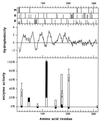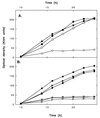CzcD is a heavy metal ion transporter involved in regulation of heavy metal resistance in Ralstonia sp. strain CH34
- PMID: 10559151
- PMCID: PMC94160
- DOI: 10.1128/JB.181.22.6876-6881.1999
CzcD is a heavy metal ion transporter involved in regulation of heavy metal resistance in Ralstonia sp. strain CH34
Abstract
The Czc system of Ralstonia sp. strain CH34 mediates resistance to cobalt, zinc, and cadmium through ion efflux catalyzed by the CzcCB(2)A cation-proton antiporter. The CzcD protein is involved in the regulation of the Czc system. It is a membrane-bound protein with at least four transmembrane alpha-helices and is a member of a subfamily of the cation diffusion facilitator (CDF) protein family, which occurs in all three domains of life. The deletion of czcD in a Ralstonia sp. led to partially constitutive expression of the Czc system due to an increased transcription of the structural czcCBA genes, both in the absence and presence of inducers. The czcD deletion could be fully complemented in trans by CzcD and two other CDF proteins from Saccharomyces cerevisiae, ZRC1p and COT1p. All three proteins mediated a small but significant resistance to cobalt, zinc, and cadmium in Ralstonia, and this resistance was based on a reduced accumulation of the cations. Thus, CzcD appeared to repress the Czc system by an export of the inducing cations.
Figures





Similar articles
-
Identification of a regulatory pathway that controls the heavy-metal resistance system Czc via promoter czcNp in Ralstonia metallidurans.Arch Microbiol. 2004 Oct;182(2-3):109-18. doi: 10.1007/s00203-004-0670-8. Epub 2004 Aug 31. Arch Microbiol. 2004. PMID: 15340798
-
Characteristics of zinc transport by two bacterial cation diffusion facilitators from Ralstonia metallidurans CH34 and Escherichia coli.J Bacteriol. 2004 Nov;186(22):7499-507. doi: 10.1128/JB.186.22.7499-7507.2004. J Bacteriol. 2004. PMID: 15516561 Free PMC article.
-
Transcriptional organization of the czc heavy-metal homeostasis determinant from Alcaligenes eutrophus.J Bacteriol. 1999 Apr;181(8):2385-93. doi: 10.1128/JB.181.8.2385-2393.1999. J Bacteriol. 1999. PMID: 10198000 Free PMC article.
-
Cupriavidus metallidurans: evolution of a metal-resistant bacterium.Antonie Van Leeuwenhoek. 2009 Aug;96(2):115-39. doi: 10.1007/s10482-008-9284-5. Epub 2008 Oct 1. Antonie Van Leeuwenhoek. 2009. PMID: 18830684 Review.
-
Resistance to cadmium, cobalt, zinc, and nickel in microbes.Plasmid. 1992 Jan;27(1):17-28. doi: 10.1016/0147-619x(92)90003-s. Plasmid. 1992. PMID: 1741458 Review.
Cited by
-
Genomic Insights Into New Species of the Genus Halomicroarcula Reveals Potential for New Osmoadaptative Strategies in Halophilic Archaea.Front Microbiol. 2021 Nov 4;12:751746. doi: 10.3389/fmicb.2021.751746. eCollection 2021. Front Microbiol. 2021. PMID: 34803972 Free PMC article.
-
Enterococcus faecalis Manganese Exporter MntE Alleviates Manganese Toxicity and Is Required for Mouse Gastrointestinal Colonization.Infect Immun. 2020 May 20;88(6):e00058-20. doi: 10.1128/IAI.00058-20. Print 2020 May 20. Infect Immun. 2020. PMID: 32229614 Free PMC article.
-
The Lysobacter capsici AZ78 Genome Has a Gene Pool Enabling it to Interact Successfully with Phytopathogenic Microorganisms and Environmental Factors.Front Microbiol. 2016 Feb 5;7:96. doi: 10.3389/fmicb.2016.00096. eCollection 2016. Front Microbiol. 2016. PMID: 26903975 Free PMC article.
-
Dysregulation of transition metal ion homeostasis is the molecular basis for cadmium toxicity in Streptococcus pneumoniae.Nat Commun. 2015 Mar 3;6:6418. doi: 10.1038/ncomms7418. Nat Commun. 2015. PMID: 25731976 Free PMC article.
-
Bacterial swimming, swarming and chemotactic response to heavy metal presence: which could be the influence on wastewater biotreatment efficiency?World J Microbiol Biotechnol. 2012 Sep;28(9):2813-25. doi: 10.1007/s11274-012-1091-5. Epub 2012 Jun 8. World J Microbiol Biotechnol. 2012. PMID: 22806721
References
-
- Brim H, Heyndrickx M, De Vos P, Wilmotte A, Springael D, Schlegel H G, Mergeay M. Amplified rDNA restriction analysis and further genotypic characterisation of metal-resistant soil bacteria and related facultative hydrogenotrophs. Syst Appl Microbiol. 1999;22:258–268. - PubMed
-
- Deretic V, Chandrasekharappa S, Gill J F, Chatterjee D K, Chakrabarty A. A set of cassettes and improved vectors for genetic and biochemical characterization of Pseudomonas genes. Gene. 1987;57:61–72. - PubMed
-
- Inoue Y, Kobayashi S, Kimura A. Cloning and phenotypic characterization of a gene enhancing resistance against oxidative stress in Saccharomyces cerevisiae. J Ferment Bioeng. 1993;75:327–331.
Publication types
MeSH terms
Substances
LinkOut - more resources
Full Text Sources
Other Literature Sources
Molecular Biology Databases

